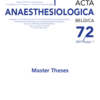Intranasal dexmedetomidine to facilitate mask induction and prevent emergence delirium
Dexmedetomidine; premedication; pediatric; administration, intra-nasal; delirium
Published online: Apr 21 2022
Abstract
As children are exposed to stress and anxiety during the perioperative period, pre-anesthetic medication to facilitate induction of anesthesia without prolonging recovery is needed. Dexmedetomidine is increasingly being used for sedation in the intensive care units and for procedural anesthesia outside the operating room. However, the effectiveness of pre-operative sedation with intranasal dexmedetomidine in pediatric patients undergoing ambulatory surgery has not yet been well characterized. Therefore, the aim was to identify the effectiveness of intranasal dexmedetomidine in facilitating mask induction and preventing emergence agitation.
In a single center retrospective implementation study, we compared intranasal dexmedetomidine (2 µg/kg) administration, sequentially in all pediatric patients undergoing minor urological surgery between January 2019 and July 2019 with a period in which dexmedetomidine was not administered. The outcome measures were tolerance of mask induction, post-operative sedation and the Pediatric Anesthesia Emergence Delirium scale (PAED) score.
The 53 children in the control group were compared with 50 children in the dexmedetomidine group during implementation. The incidence of sedation on mask induction was greater in patients given dexmedetomidine compared to those who did not receive premedication (60% versus 0%, p<0.0001). The proportion of children who were asleep but easily arousable in the recovery room and in day-care hospital was greater in the dexmedetomidine group compared to the control group. (32% versus 7% in the recovery room; p=0.004, and 20% versus 2% in day-care hospital, p = 0.002). The PAED scores did not differ between the two groups, neither in the recovery room nor in day-care hospital.
In pediatric patients undergoing small urologic surgery, premedication with intranasal dexmedetomidine in a dose of 2µg/kg provides adequate sedation and anxio-lysis on mask induction and in the postoperative period. These results from an implementation study need to be confirmed in a multicenter blinded randomized controlled trial.
